bonnet MERCEDES-BENZ ML SUV 2008 Owners Manual
[x] Cancel search | Manufacturer: MERCEDES-BENZ, Model Year: 2008, Model line: ML SUV, Model: MERCEDES-BENZ ML SUV 2008Pages: 381, PDF Size: 7.18 MB
Page 7 of 381
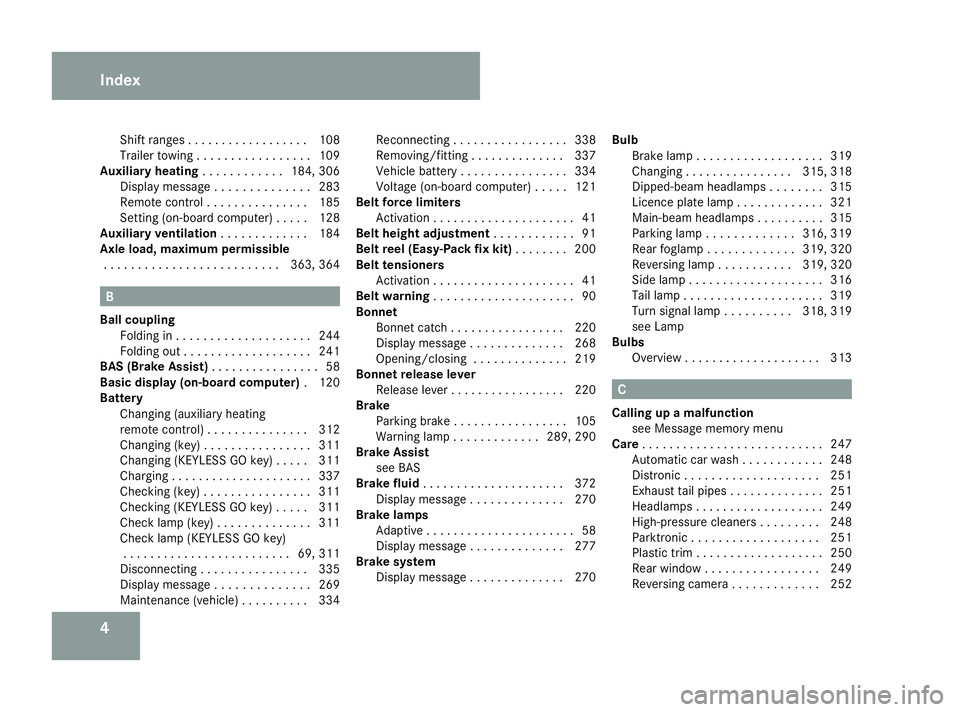
4Shift ranges . . . . . . . . . . . . . . . . .
.108
Trailer towing . . . . . . . . . . . . . . . . .109
Auxiliary heating . . . . . . . . . . ..184, 306
Display message . . . . . . . . . . . . . .283
Remote control . . . . . . . . . . . . . . .185
Setting (on-board computer) . . . . .128
Auxiliary ventilation . . . . . . . . . . . ..184
Axle load, maximum permissible
. . . . . . . . . . . . . . . . . . . . . . . . . .363, 364 B
Ball coupling Folding in . . . . . . . . . . . . . . . . . . . .244
Folding out . . . . . . . . . . . . . . . . . . .241
BAS (Brake Assist) . . . . . . . . . . . . . . ..58
Basic display (on-board computer) .120
Battery Changing (auxiliary heating
remote control) . . . . . . . . . . . . . . .312
Changing (key ).. . . . . . . . . . . . . . .311
Changing (KEYLESS GO key) . . . . .311
Charging . . . . . . . . . . . . . . . . . . . . .337
Checking (key ).. . . . . . . . . . . . . . .311
Checking (KEYLESS GO key) . . . . .311
Check lamp (key ).. . . . . . . . . . . . .311
Check lamp (KEYLESS GO key) . . . . . . . . . . . . . . . . . . . . . . . . .69, 311
Disconnecting . . . . . . . . . . . . . . . .335
Display message . . . . . . . . . . . . . .269
Maintenance (vehicle ).. . . . . . . ..334 Reconnecting . . . . . . . . . . . . . . . .
.338
Removing/fitting . . . . . . . . . . . . . .337
Vehicle battery . . . . . . . . . . . . . . . .334
Voltage (on-board computer) . . . . .121
Belt force limiters
Activatio n.. . . . . . . . . . . . . . . . . . . .41
Belt height adjustment . . . . . . . . . . ..91
Belt reel (Easy-Pack fix kit) . . . . . . ..200
Belt tensioners Activatio n.. . . . . . . . . . . . . . . . . . . .41
Belt warning . . . . . . . . . . . . . . . . . . . . .90
Bonnet Bonnet catch . . . . . . . . . . . . . . . . .220
Display message . . . . . . . . . . . . . .268
Opening/closing . . . . . . . . . . . . . .219
Bonnet release lever
Release lever . . . . . . . . . . . . . . . . .220
Brake
Parking brake . . . . . . . . . . . . . . . . .105
Warning lamp . . . . . . . . . . . . .289, 290
Brake Assist
see BAS
Brake fluid . . . . . . . . . . . . . . . . . . . . .372
Display message . . . . . . . . . . . . . .270
Brake lamps
Adaptive . . . . . . . . . . . . . . . . . . . . . .58
Display message . . . . . . . . . . . . . .277
Brake system
Display message . . . . . . . . . . . . . .270 Bulb
Brake lamp . . . . . . . . . . . . . . . . . . .319
Changing . . . . . . . . . . . . . . . .315, 318
Dipped-beam headlamps . . . . . . . .315
Licence plate lamp . . . . . . . . . . . . .321
Main-beam headlamps . . . . . . . . . .315
Parking lamp . . . . . . . . . . . . .316, 319
Rear foglamp . . . . . . . . . . . . .319, 320
Reversing lamp . . . . . . . . . . .319, 320
Side lamp . . . . . . . . . . . . . . . . . . . .316
Tail lamp . . . . . . . . . . . . . . . . . . . . .319
Turn signal lamp . . . . . . . . . .318, 319
see Lamp
Bulbs
Overview . . . . . . . . . . . . . . . . . . . .313 C
Calling up a malfunction see Message memory menu
Care . . . . . . . . . . . . . . . . . . . . . . . . . . .247
Automatic car wash . . . . . . . . . . . .248
Distronic . . . . . . . . . . . . . . . . . . . .251
Exhaust tail pipes . . . . . . . . . . . . . .251
Headlamps . . . . . . . . . . . . . . . . . . .249
High-pressure cleaners . . . . . . . . .248
Parktroni c.. . . . . . . . . . . . . . . . . .251
Plastic trim . . . . . . . . . . . . . . . . . . .250
Rear window . . . . . . . . . . . . . . . . .249
Reversing camera . . . . . . . . . . . . .252 Index
164_AKB; 5; 5, en-GB
wobuchh,
Version: 2.10.6 2008-05-11T11:55:12+02:00 - Seite 4Dateiname: 6515_4293_02_buchblock.pdf; preflight
Page 24 of 381
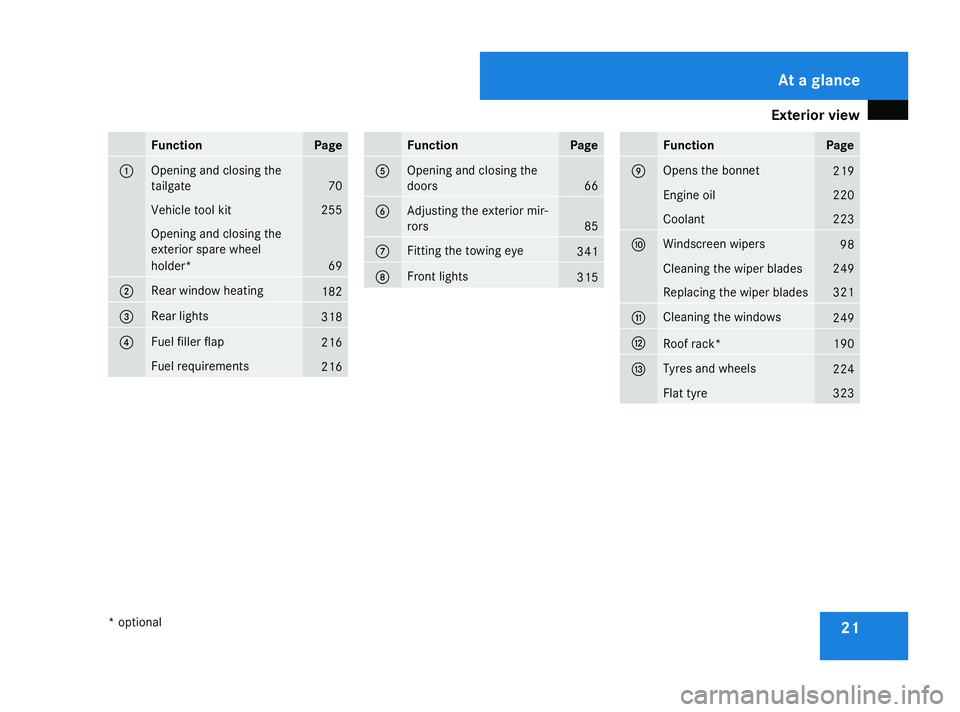
Exterior view
21Function Page
1 Opening and closing the
tailgate 70
Vehicle tool kit 255
Opening and closing the
exterior spare wheel
holder* 69
2 Rear window heating
182
3 Rear lights
318
4 Fuel filler flap
216
Fuel requirements
216 Function Page
5 Opening and closing the
doors 66
6 Adjusting the exterior mir-
rors
85
7 Fitting the towing eye
341
8 Front lights
315 Function Page
9 Opens the bonnet
219
Engine oil 220
Coolant 223
a Windscreen wipers
98
Cleaning the wiper blades 249
Replacing the wiper blades 321
b Cleaning the windows
249
c
Roof rack* 190
d Tyres and wheels
224
Flat tyre 323At a glance
* optional
164_AKB; 5; 5, en-GB
wobuchh,
Version: 2.10.6 2008-05-11T11:55:12+02:00 - Seite 21Dateiname: 6515_4293_02_buchblock.pdf; preflight
Page 26 of 381
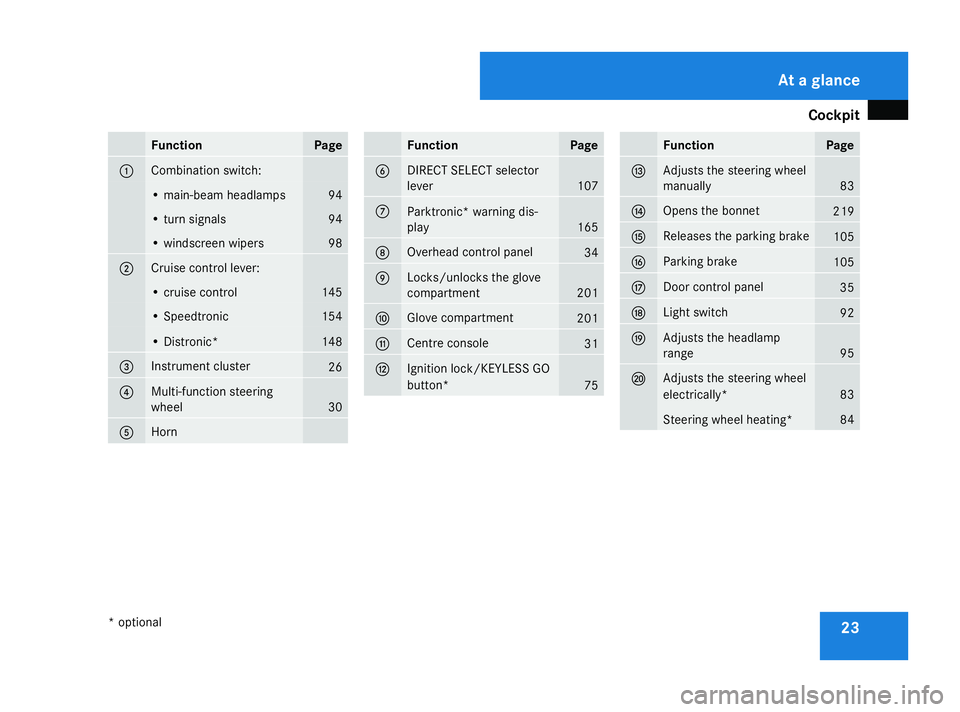
Cockpit
23Function Page
1 Combination switch:
• main-beam headlamps 94
• turn signals 94
• windscreen wipers 98
2 Cruise control lever:
• cruise control 145
• Speedtronic 154
• Distronic* 148
3 Instrument cluster
26
4 Multi-function steering
wheel
30
5 Horn Function Page
6 DIRECT SELECT selector
lever
107
7
Parktronic* warning dis-
play
165
8 Overhead control panel
34
9 Locks/unlocks the glove
compartment 201
a Glove compartment
201
b Centre console
31
c Ignition lock/KEYLESS GO
button*
75 Function Page
d Adjusts the steering wheel
manually
83
e Opens the bonnet
219
f Releases the parking brake
105
g Parking brake
105
h Door control panel
35
j Light switch
92
k Adjusts the headlamp
range
95
l Adjusts the steering wheel
electrically*
83
Steering wheel heating* 84At a glance
* optional
164_AKB; 5; 5, en-GB
wobuchh,
Version: 2.10.6 2008-05-11T11:55:12+02:00 - Seite 23Dateiname: 6515_4293_02_buchblock.pdf; preflight
Page 28 of 381
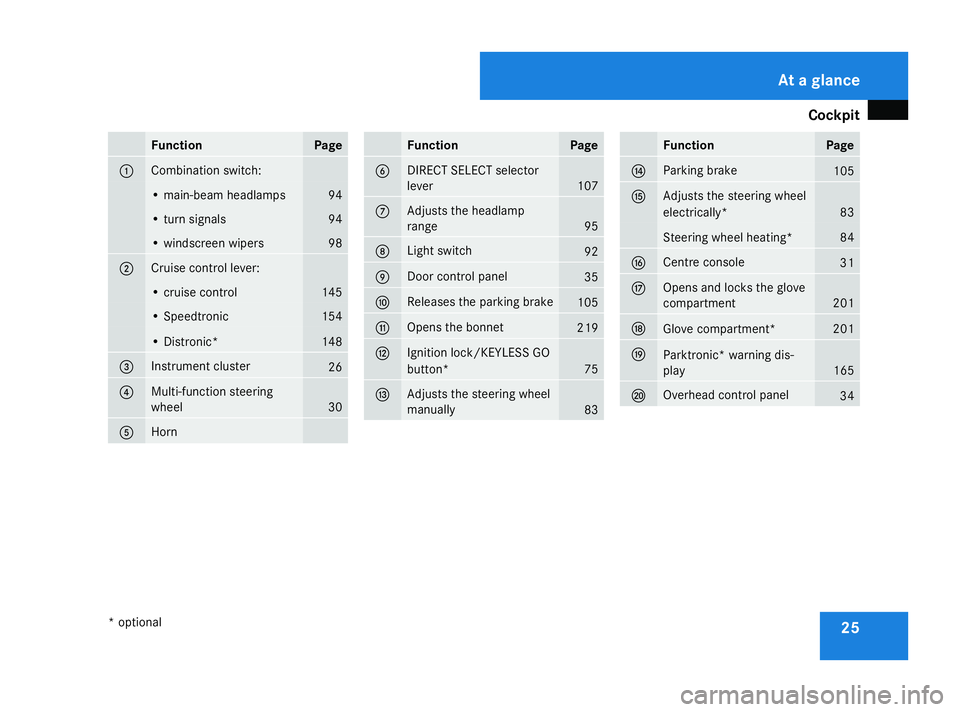
Cockpit
25Function Page
1 Combination switch:
• main-beam headlamps 94
• turn signals 94
• windscreen wipers 98
2 Cruise control lever:
• cruise control 145
• Speedtronic 154
• Distronic* 148
3 Instrument cluster
26
4 Multi-function steering
wheel
30
5 Horn Function Page
6 DIRECT SELECT selector
lever
107
7 Adjusts the headlamp
range
95
8 Light switch
92
9 Door control panel
35
a Releases the parking brake
105
b Opens the bonnet
219
c Ignition lock/KEYLESS GO
button*
75
d Adjusts the steering wheel
manually
83 Function Page
e Parking brake
105
f Adjusts the steering wheel
electrically*
83
Steering wheel heating* 84
g Centre console
31
h Opens and locks the glove
compartment
201
j
Glove compartment* 201
k
Parktronic* warning dis-
play
165
l Overhead control panel
34At a glance
* optional
164_AKB; 5; 5, en-GB
wobuchh,
Version: 2.10.6 2008-05-11T11:55:12+02:00 - Seite 25Dateiname: 6515_4293_02_buchblock.pdf; preflight
Page 45 of 381
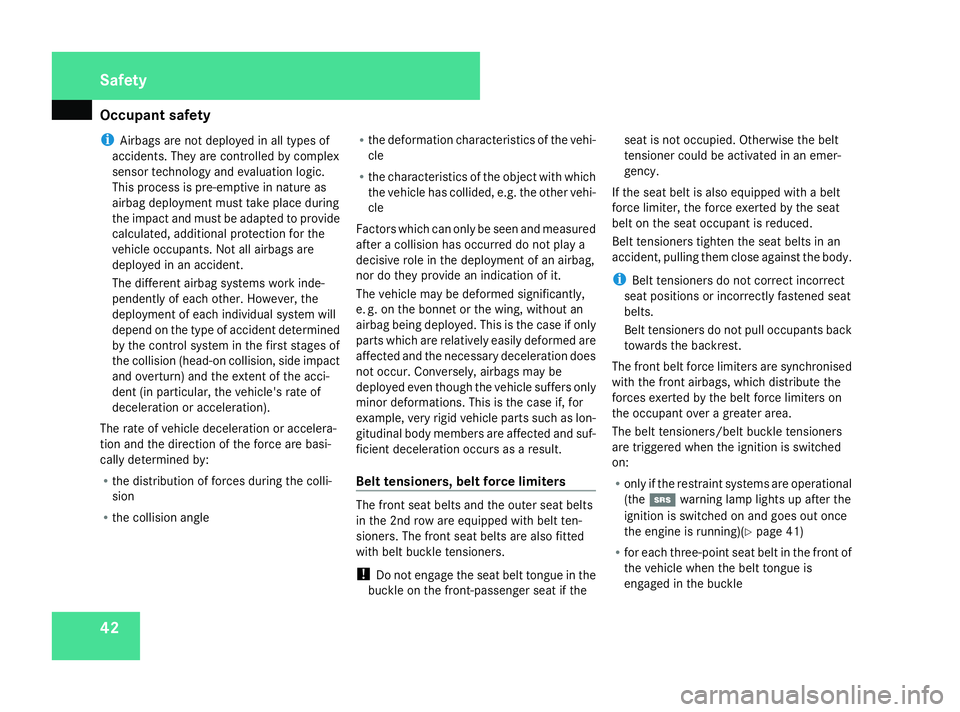
Occupant safety
42
i
Airbags are not deployed in all types of
accidents. They are controlled by complex
sensor technology and evaluation logic.
This process is pre-emptive in nature as
airbag deployment must take place during
the impact and must be adapted to provide
calculated, additional protection for the
vehicle occupants. Not all airbags are
deployed in an accident.
The different airbag systems work inde-
pendently of each other. However, the
deployment of each individual system will
depend on the type of accident determined
by the control system in the first stages of
the collision (head-on collision, side impact
and overturn) and the extent of the acci-
dent (in particular, the vehicle's rate of
deceleration or acceleration).
The rate of vehicle deceleration or accelera-
tion and the direction of the force are basi-
cally determined by:
R the distribution of forces during the colli-
sion
R the collision angle R
the deformation characteristics of the vehi-
cle
R the characteristics of the object with which
the vehicle has collided, e.g. the other vehi-
cle
Factors which can only be seen and measured
after a collision has occurred do not play a
decisive role in the deployment of an airbag,
nor do they provide an indication of it.
The vehicle may be deformed significantly,
e. g. on the bonnet or the wing, without an
airbag being deployed. This is the case if only
parts which are relatively easily deformed are
affected and the necessary deceleration does
not occur. Conversely, airbags may be
deployed even though the vehicle suffers only
minor deformations. This is the case if, for
example, very rigid vehicle parts such as lon-
gitudinal body members are affected and suf-
ficient deceleration occurs as a result.
Belt tensioners, belt force limiters The front seat belts and the outer seat belts
in the 2nd row are equipped with belt ten-
sioners. The front seat belts are also fitted
with belt buckle tensioners.
!
Do not engage the seat belt tongue in the
buckle on the front-passenger seat if the seat is not occupied. Otherwise the belt
tensioner could be activated in an emer-
gency.
If the seat belt is also equipped with a belt
force limiter, the force exerted by the seat
belt on the seat occupant is reduced.
Belt tensioners tighten the seat belts in an
accident, pulling them close against the body.
i Belt tensioners do not correct incorrect
seat positions or incorrectly fastened seat
belts.
Belt tensioners do not pull occupants back
towards the backrest.
The front belt force limiters are synchronised
with the front airbags, which distribute the
forces exerted by the belt force limiters on
the occupant over a greater area.
The belt tensioners/belt buckle tensioners
are triggered when the ignition is switched
on:
R only if the restraint systems are operational
(the 1 warning lamp lights up after the
ignition is switched on and goes out once
the engine is running)(Y page 41)
R for each three-point seat belt in the front of
the vehicle when the belt tongue is
engaged in the buckle Safety
164_AKB; 5; 5, en-GB
wobuchh,
Version: 2.10.6 2008-05-11T11:55:12+02:00 - Seite 42Dateiname: 6515_4293_02_buchblock.pdf; preflight
Page 65 of 381
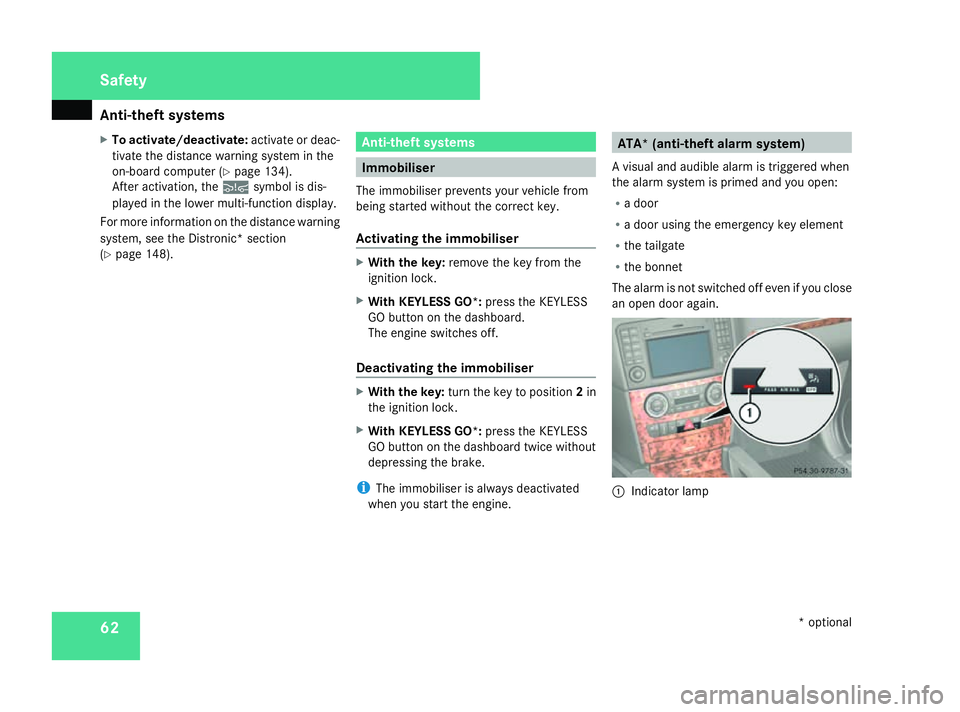
Anti-theft syste
ms62
X
To activate/deactivate: activate or deac-
tivate the distance warning system in the
on-board computer (Y page 134).
After activation, the :symbol is dis-
played in the lower multi-function display.
For more information on the distance warning
system, see the Distronic* section
(Y page 148). Anti-theft systems
Immobiliser
The immobiliser prevents your vehicle from
being started without the correct key.
Activating the immobiliser X
With the key: remove the key from the
ignition lock.
X With KEYLESS GO*: press the KEYLESS
GO button on the dashboard.
The engine switches off.
Deactivating the immobiliser X
With the key: turn the key to position 2in
the ignition lock.
X With KEYLESS GO*: press the KEYLESS
GO button on the dashboard twice without
depressing the brake.
i The immobiliser is always deactivated
when you start the engine. ATA* (anti-theft alarm system)
A visual and audible alarm is triggered when
the alarm system is primed and you open:
R a door
R a door using the emergency key element
R the tailgate
R the bonnet
The alarm is not switched off even if you close
an open door again. 1
Indicator lamp Safety
* optional
164_AKB; 5; 5, en-GB
wobuchh,
Version: 2.10.6 2008-05-11T11:55:12+02:00 - Seite 62Dateiname: 6515_4293_02_buchblock.pdf; preflight
Page 182 of 381
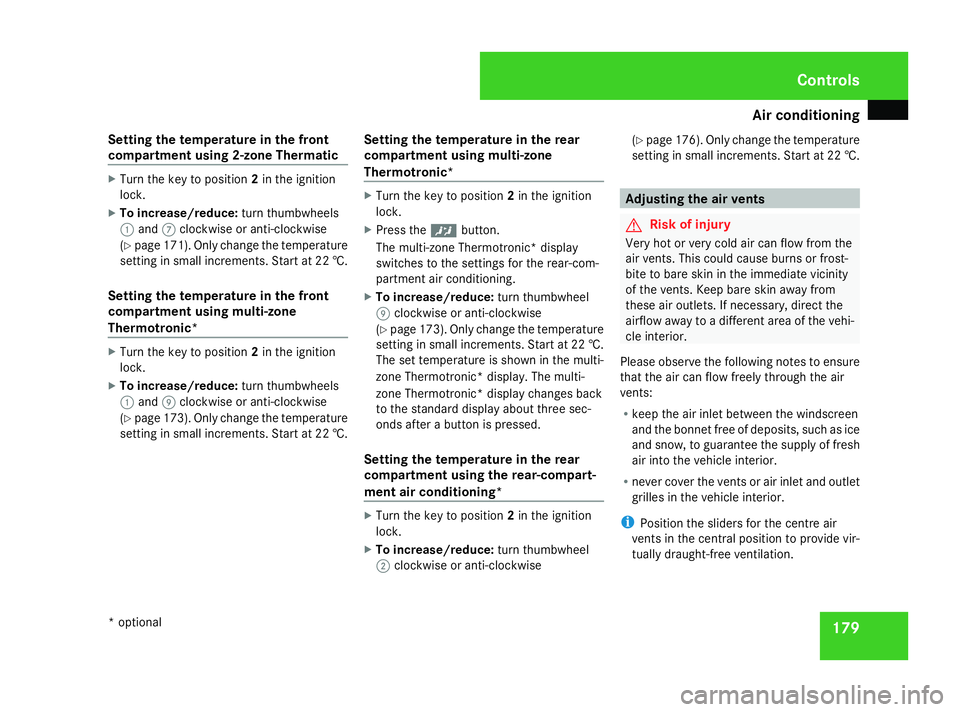
Air conditioning
179
Setting the temperature in the front
compartment using 2-zone Thermatic X
Turn the key to position 2in the ignition
lock.
X To increase/reduce: turn thumbwheels
1 and 7clockwise or anti-clockwise
(Y page 171). Only change the temperature
setting in small increments. Start at 22 †.
Setting the temperature in the front
compartment using multi-zone
Thermotronic* X
Turn the key to position 2in the ignition
lock.
X To increase/reduce: turn thumbwheels
1 and 9clockwise or anti-clockwise
(Y page 173). Only change the temperature
setting in small increments. Start at 22 †. Setting the temperature in the rear
compartment using multi-zone
Thermotronic* X
Turn the key to position 2in the ignition
lock.
X Press the ™button.
The multi-zone Thermotronic* display
switches to the settings for the rear-com-
partment air conditioning.
X To increase/reduce: turn thumbwheel
9 clockwise or anti-clockwise
(Y page 173). Only change the temperature
setting in small increments. Start at 22 †.
The set temperature is shown in the multi-
zone Thermotronic* display. The multi-
zone Thermotronic* display changes back
to the standard display about three sec-
onds after a button is pressed.
Setting the temperature in the rear
compartment using the rear-compart-
ment air conditioning* X
Turn the key to position 2in the ignition
lock.
X To increase/reduce: turn thumbwheel
2 clockwise or anti-clockwise (Y
page 176). Only change the temperature
setting in small increments. Start at 22 †. Adjusting the air vents
G
Risk of injury
Very hot or very cold air can flow from the
air vents. This could cause burns or frost-
bite to bare skin in the immediate vicinity
of the vents. Keep bare skin away from
these air outlets. If necessary, direct the
airflow away to a different area of the vehi-
cle interior.
Please observe the following notes to ensure
that the air can flow freely through the air
vents:
R keep the air inlet between the windscreen
and the bonnet free of deposits, such as ice
and snow, to guarantee the supply of fresh
air into the vehicle interior.
R never cover the vents or air inlet and outlet
grilles in the vehicle interior.
i Position the sliders for the centre air
vents in the central position to provide vir-
tually draught-free ventilation. Cont
rols
* optional
164_AKB; 5; 5, en-GB
wobuchh
,V ersion: 2.10.6
2008-05-11T11:55:12+02:00 - Seite 179 ZDateiname: 6515_4293_02_buchblock.pdf; preflight
Page 222 of 381
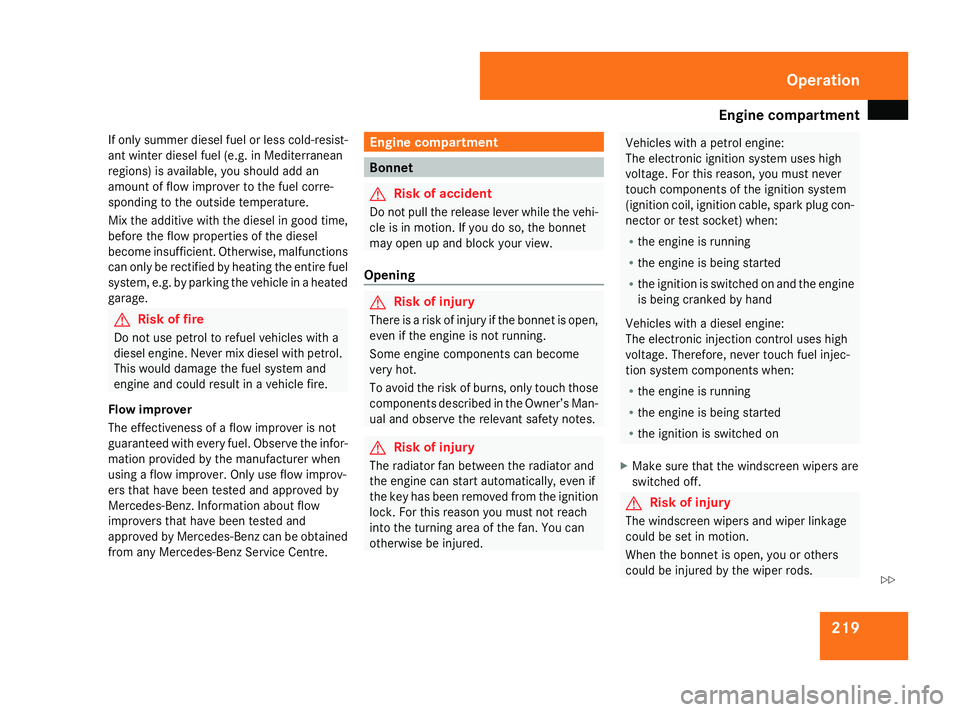
Engine compartment
219
If only summer diesel fuel or less cold-resist-
ant winter diesel fuel (e.g. in Mediterranean
regions) is available, you should add an
amount of flow improver to the fuel corre-
sponding to the outside temperature.
Mix the additive with the diesel in good time,
before the flow properties of the diesel
become insufficient. Otherwise, malfunctions
can only be rectified by heating the entire fuel
system, e.g. by parking the vehicle in a heated
garage. G
Risk of fire
Do not use petrol to refuel vehicles with a
diesel engine. Never mix diesel with petrol.
This would damage the fuel system and
engine and could result in a vehicle fire.
Flow improver
The effectiveness of a flow improver is not
guaranteed with every fuel. Observe the infor-
mation provided by the manufacturer when
using a flow improver. Only use flow improv-
ers that have been tested and approved by
Mercedes-Benz. Information about flow
improvers that have been tested and
approved by Mercedes-Benz can be obtained
from any Mercedes-Benz Service Centre. Engine compartment
Bonnet
G
Risk of accident
Do not pull the release lever while the vehi-
cle is in motion. If you do so, the bonnet
may open up and block your view.
Opening G
Risk of injury
There is a risk of injury if the bonnet is open,
even if the engine is not running.
Some engine components can become
very hot.
To avoid the risk of burns, only touch those
components described in the Owner’s Man-
ual and observe the relevant safety notes. G
Risk of injury
The radiator fan between the radiator and
the engine can start automatically, even if
the key has been removed from the ignition
lock. For this reason you must not reach
into the turning area of the fan. You can
otherwise be injured. Vehicles with a petrol engine:
The electronic ignition system uses high
voltage. For this reason, you must never
touch components of the ignition system
(ignition coil, ignition cable, spark plug con-
nector or test socket) when:
R the engine is running
R the engine is being started
R the ignition is switched on and the engine
is being cranked by hand
Vehicles with a diesel engine:
The electronic injection control uses high
voltage. Therefore, never touch fuel injec-
tion system components when:
R the engine is running
R the engine is being started
R the ignition is switched on
X Make sure that the windscreen wipers are
switched off. G
Risk of injury
The windscreen wipers and wiper linkage
could be set in motion.
When the bonnet is open, you or others
could be injured by the wiper rods. Operation
164_AKB; 5; 5, en-GB
wobuchh,
Version: 2.10.6 2008-05-11T11:55:12+02:00 - Seite 219 ZDateiname: 6515_4293_02_buchblock.pdf; preflight
Page 223 of 381
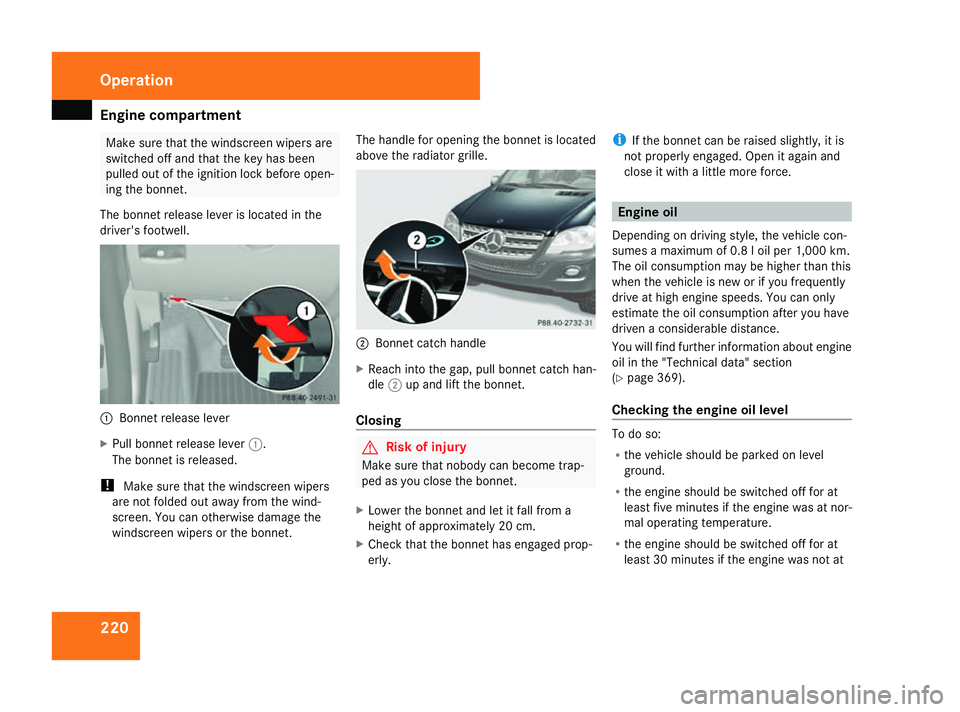
Engine compartment
220 Make sure that the windscreen wipers are
switched off and that the key has been
pulled out of the ignition lock before open-
ing the bonnet.
The bonnet release lever is located in the
driver's footwell. 1
Bonnet release lever
X Pull bonnet release lever 1.
The bonnet is released.
! Make sure that the windscreen wipers
are not folded out away from the wind-
screen. You can otherwise damage the
windscreen wipers or the bonnet. The handle for opening the bonnet is located
above the radiator grille.
2
Bonnet catch handle
X Reach into the gap, pull bonnet catch han-
dle 2up and lift the bonnet.
Closing G
Risk of injury
Make sure that nobody can become trap-
ped as you close the bonnet.
X Lower the bonnet and let it fall from a
height of approximately 20 cm.
X Check that the bonnet has engaged prop-
erly. i
If the bonnet can be raised slightly, it is
not properly engaged. Open it again and
close it with a little more force. Engine oil
Depending on driving style, the vehicle con-
sumes a maximum of 0.8 l oil per 1,000 km.
The oil consumption may be higher than this
when the vehicle is new or if you frequently
drive at high engine speeds. You can only
estimate the oil consumption after you have
driven a considerable distance.
You will find further information about engine
oil in the "Technical data" section
(Y page 369).
Checking the engine oil level To do so:
R
the vehicle should be parked on level
ground.
R the engine should be switched off for at
least five minutes if the engine was at nor-
mal operating temperature.
R the engine should be switched off for at
least 30 minutes if the engine was not at Operation
164_AKB; 5; 5, en-GB
wobuchh,
Version: 2.10.6 2008-05-11T11:55:12+02:00 - Seite 220Dateiname: 6515_4293_02_buchblock.pdf; preflight
Page 252 of 381
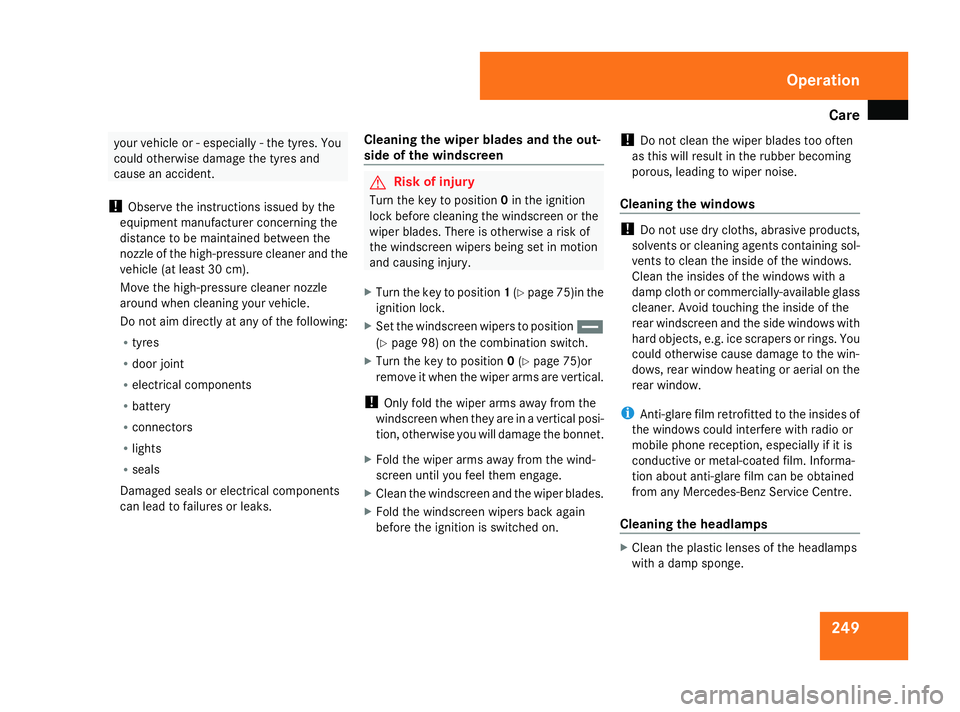
Care
249your vehicle or - especially - the tyres. You
could otherwise damage the tyres and
cause an accident.
! Observe the instructions issued by the
equipment manufacturer concerning the
distance to be maintained between the
nozzle of the high-pressure cleaner and the
vehicle (at least 30 cm).
Move the high-pressure cleaner nozzle
around when cleaning your vehicle.
Do not aim directly at any of the following:
R tyres
R door joint
R electrical components
R battery
R connectors
R lights
R seals
Damaged seals or electrical components
can lead to failures or leaks. Cleaning the wiper blades and the out-
side of the windscreen G
Risk of injury
Turn the key to position 0in the ignition
lock before cleaning the windscreen or the
wiper blades. There is otherwise a risk of
the windscreen wipers being set in motion
and causing injury.
X Turn the key to position 1(Y page 75)in the
ignition lock.
X Set the windscreen wipers to position u
(Y page 98) on the combination switch.
X Turn the key to position 0(Y page 75)or
remove it when the wiper arms are vertical.
! Only fold the wiper arms away from the
windscreen when they are in a vertical posi-
tion, otherwise you will damage the bonnet.
X Fold the wiper arms away from the wind-
screen until you feel them engage.
X Clean the windscreen and the wiper blades.
X Fold the windscreen wipers back again
before the ignition is switched on. !
Do not clean the wiper blades too often
as this will result in the rubber becoming
porous, leading to wiper noise.
Cleaning the windows !
Do not use dry cloths, abrasive products,
solvents or cleaning agents containing sol-
vents to clean the inside of the windows.
Clean the insides of the windows with a
damp cloth or commercially-available glass
cleaner. Avoid touching the inside of the
rear windscreen and the side windows with
hard objects, e.g. ice scrapers or rings. You
could otherwise cause damage to the win-
dows, rear window heating or aerial on the
rear window.
i Anti-glare film retrofitted to the insides of
the windows could interfere with radio or
mobile phone reception, especially if it is
conductive or metal-coated film. Informa-
tion about anti-glare film can be obtained
from any Mercedes-Benz Service Centre.
Cleaning the headlamps X
Clean the plastic lenses of the headlamps
with a damp sponge. Operation
164_AKB; 5; 5, en-GB
wobuchh,
Version: 2.10.6 2008-05-11T11:55:12+02:00 - Seite 249 ZDateiname: 6515_4293_02_buchblock.pdf; preflight